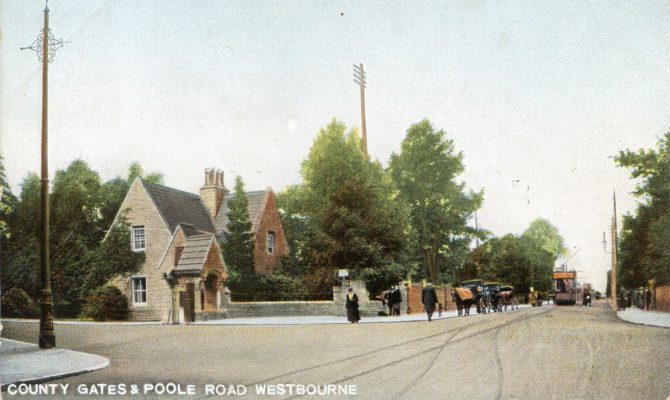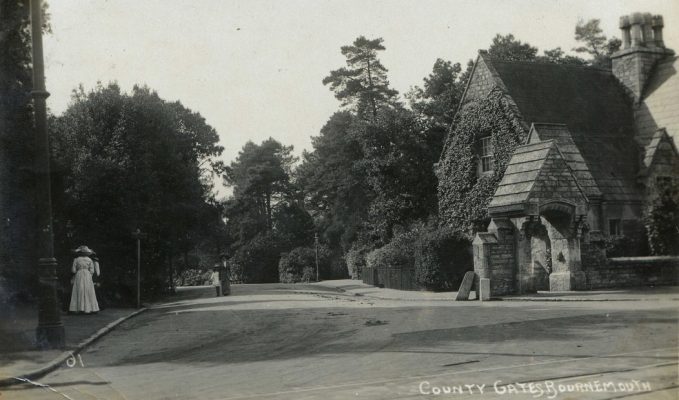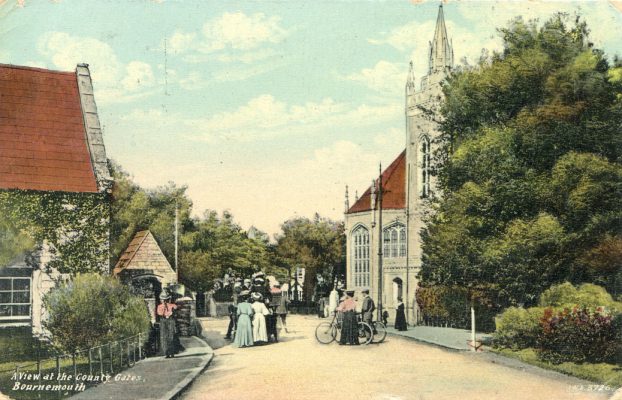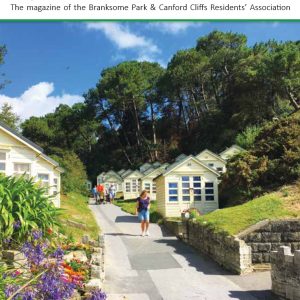The memories of my early days in Branksome Park made a lasting impression which I shall never forget because the scene was so peaceful and unspoilt. When I came back to Bournemouth from time to time it was to see small parts of our beautiful district steadily being altered by what was termed improvements. These changes were barely noticeable at the time when we had long hot summers, and time seemed to stand still. One of the most impressive sights to be seen was the massive iron gates at the northern end of The Avenue at County Gates. These were manned by two immaculate custodians, top-hatted with white gloves, striped trousers and green or yellow waistcoats. These guardians questioned anyone who wanted to enter Branksome Park, as to their business etc. before entry was permitted.
The Avenue was a gravelled drive to Branksome Towers and the sea, and on either side were banks of exotic rhododendrons some eight feet high. Landaus and various kinds of horse-drawn vehicles, mostly belonging to owners of other large houses in the Park, proudly made their way up and down this magnificent Avenue, which was kept in immaculate condition. Many of the roads in the Park were unadopted, some were gravelled, petering out in sand tracks to the sea. The whole area was maintained in a tidy condition, shrubs and trees were everywhere, and the fir trees in those days were in their prime.
I made up my mind that one day I would come back here to live and retire and, as most of you know, when I did I was called upon to play a major part in trying to prevent over-development by the formation of the Residents’ Association. I came back here to live in 1957 and by then our liveried custodians at County Gates had disappeared together with the Gates. Branksome Towers had become a famous hotel. Large estates in the Park were still in evidence, and Aston Court was a show place, open to the public to view exotic specimens of tropical, and other flowers and plants.
In 1958 I could see that if some representation was not made, the whole area might be devastated, and I was determined to stop the rot. The Association was comprised of eight Covenant Holders, who controlled all aspects of development etc. in collaboration with Poole Borough Council. One of the Covenant Holders at the time was also Chairman of the Poole Borough Council’s Planning Committee, as well as being Chairman of the Covenant Holding Company, known as the Branksome Park Association. I attended a meeting of the Association at which there was a very small number of residents’ present. I offered to become a recruiting officer, to which the Chairman agreed, and also for me to attend their monthly meetings, but without voting rights. I felt that we should have a Residents’ Association to build up a better relationship with the Council and Councillors and prevent as much as possible any over-development of our beautiful district.
My wife and I then set out on a recruiting drive, and in our first year we managed to get over 100 members most of whom attended an A.G.M. of the Covenant Holders. With an overwhelming majority the Branksome Park Residents’ Association was formed with our own Chairman and Committee. Under the new organisation it was agreed that I would attend all Covenant Holders meetings, now called the Branksome Park Association Ltd and would report back to our Residents’ Association. I was thus able to keep in touch with all planning applications and their outcome. As Planning Officer for the Residents’ Association, a very strong relationship was built up with Council Officials and Councillors, together with other Residents’ Associations as far as Broadstone. As we gathered strength our Association came to be recognised, its views
respected and accepted in the majority of cases. My wife and I continued to work hard to increase our numbers until we found much more help was required, and so responsibilities were delegated to members of the Committee. Meetings were held each month in my home and planning meetings held each month.
The Covenants were eventually taken over by a resident in the Park and I continued to meet him each month, or sometimes more frequently, to discuss, and make recommendations concerning planning applications. The Covenants were again sold to another resident in the luxury bungalow building trade and I was invited to become an unpaid Director of the Company so as to maintain a close liaison between the Company and Residents’. Under this arrangement the Council used to send all planning applications to the Company and Residents’ Association for comment and recommendations. I resigned from the Board about two years ago because the Company was sold to a flat developer and I felt that I would not be able to agree to over-development which I envisaged would follow. I formed a Joint Ratepayers’ Association backed by the Broadstone Association and meetings were held each month. They were strictly non-political, and we managed to get one or two Residents’ Association Councillors elected. Only a few of our Committee Members at that time are still alive today, but without them and their loyal support, we should have been submerged in a concrete jungle of much larger proportions than what it is today.
Having dealt with a sketchy background to the start of our Association, I would like to highlight some of the more important aspects relating to planning, conservation, and preservation. As I have said all planning applications great and small come to us for comment. On planning aspects, I propose to deal with them as they were presented to the Association.
The Avenue
This was the first important development, and after long and earnest discussions and Council and Company meetings it was agreed that this should be not less than 1 acre, with 16 flats per acre, of not more than 6-7 storeys high. The minimum number of trees should be felled, and shrubs preserved. No trees or shrubs should be destroyed on the boundary lines, and development should stop at Tower Road. The height of flats should be graduated down to 3-4 storeys at the Tower Road end.
Lindsay Road
This was next on the list, and eventually it was agreed with reluctance that each site should be treated on its merits. We wanted the same restrictions as laid down for the Avenue, but the Council did not agree. A very careful eye had to be kept on every planning application in this important road. Several Ministerial Inquiries were held and a few plans which were contrary to our ideals were passed. Holly Lodge was passed for a twelve-storey block, but through the passage of time it was never implemented, and we have what can be seen today as a circular development, three storeys high.
The Bridge Club and Frizzell Roundabout
Major development problems arose when proposals were made to sever a large plot on the Westbourne side of the Bridge Club, and to make a large roundabout on which would be built Frizzell House, connected by a bridge over Lindsay Road, We objected strongly against severance and recommended that the plot to be severed should remain in the residential area for flat development and that any roundabout should be further east towards Westbourne. However, the Council disagreed, but we insisted that the Frizzell Office block should not exceed three storeys. The Council agreed with us that the bridge should not be permitted, but the Ministry of Transport (as it was then) said that the bridge was necessary. Another development which we strongly opposed was a proposal to build a twelve-storey block of flats on the site of the old Bridge Club. A public meeting was arranged with Council Officials and Councillors after which the Council accepted our proposal to erect two five or six storey blocks on the site instead.
The Oratory School Site, Western Road
As a result of a Public Inquiry to build blocks of high-rise flats, the Minister agreed with the Council, which we supported, that no flats should be permitted, and after further applications we managed to get agreement on our proposal to build Town Houses which I consider was an achievement, considering we were up against a very large firm of London developers with strong legal backing.
Martello Park
High rise flats along this cliff top had been proposed, but after very lengthy discussions with the Council Officials and Councillors, agreement was finally reached that there should be only eight flats per acre, and the height restricted to three storeys with a penthouse in special cases.
Balcombe and Burton Roads developments
Again, after lengthy discussions, agreement was reached that the development should be restricted to eight flats per acre, and not to exceed four storeys. Development should not be permitted beyond Dover Road on the south side of Balcombe Road and also restricted to the east side of Burton Road.
Cerne Abbas, The Avenue
We endeavoured to get this large building listed but the Ministry said maintenance was too expensive, and so we proposed a mixed development of houses and flats, not to exceed three storeys. What has happened now is beyond my comprehension as I had no hand in its development.
The Mausoleum
This was erected for a family who owned Branksome Towers, and until the tomb was robbed of its contents very little was known locally apart from nearby residents, that such a place existed. After the robbery, many proposals were made to use it as a store, but this was strongly resisted, and it was at last agreed it should become a listed building. This took many months to organise and achieve.
The Branksome Towers Hotel
Originally, applications were made to erect six or eight blocks of eight storey flats, but eventually a mixed development was agreed with four blocks of lower rise flats on the cliff edge. In our opinion not altogether a satisfactory conclusion, but an improvement on the original proposal.
Canford Cliffs District
Prior to the formation of the very strong and active Canford Cliffs District Association, we agreed with the Council that any flat development should he restricted to low rise flats, and this has more or less been maintained.
I have not dealt with the hundreds of other planning applications concerning extensions, swimming pools, garages etc. which are too numerous to mention, and so I would like to conclude by covering other aspects of planning and development as follows:
The Baiter Road
We all know the latest proposal and the last Public Enquiry which was held and so capably handled by Mr. Tom Mayer, but I would like to go back a long time ago. A proposal was made to make a road from the Quay across the mud flats to Sandbanks Road. eventually coming out into Canford Cliffs Road, when it would enter Branksome Park via Bury Road and then on to County Gates. I was horrified at such a proposal as it would spell the end of our beautiful area, so my wife and I together with the Committee pressed for a Public meeting at the Civic Centre, The Council agreed, and a big effort was made to get as many members as possible to attend the evening meeting, which proved to be an overflow. Over 600 people attended, and some very sincere exchanges of views were made to good effect because the Council agreed to cancel the scheme and take the lane leading from Canford Cliffs Road to Bury Road off the map and use the area for bungalow development if necessary, Planning applications which are shelved have a nasty habit of rearing their ugly heads in the future, and we know only too well that this is true in the case of Baiter Road. Now the traffic has no entry into Bury Road, but it will spread out to find its way through the many other roads to County Gates.
By the time you read this we shall know the result of the Ministerial Inquiry.
Unmade Roads
There were still a few unmade roads in the Park, and these unadopted roads included Dover Road, and Close, Mornish Road, Whithingham Road and Belgrade Road. As a result of our endeavours, the Council agreed to accept the recommendations arising from residents’ petitions to keep the roads in their unmade condition providing the residents maintained them in a usable state. This has been achieved with the cooperation of the residents concerned.
Boarding Houses
The Association made strong recommendations to the Council that the number of Boarding Houses should be limited and no new applications granted. This policy in the main has been maintained.
Nursing Homes/Rest Homes
During the last five years a large number of very large houses have fallen into disuse, and as they were in the non-development area, another use had to be found. Nursing Homes or Rest Homes seemed to be the answer, and without any effort the demand has far exceeded our expectations. With the increase of these homes we recommend to the Council that all applicants should be interviewed for suitability and qualified staff should be in attendance in all cases of Nursing Homes. All buildings should be passed by the Council for suitability as Nursing or Rest Homes and be inspected once each year. Fire precautions should be strictly enforced,
Conservation and Tree Preservation
We set up a tree fund some few years ago and eventually it was used mainly to celebrate the Queen Mothers birthday by screening off the ugly spectacle at County Gates and providing a seat. It was strongly recommended by the Council that certain areas of the Park should be designated as Conservation Areas, and a Tree Preservation Act should be enforced incurring a large fine for unlawful felling or lopping of trees. A supreme effort was made by Mr. Edis who volunteered to take over the Chairmanship of the Avenue Sub-Committee, to restrict the “down to earth” cutting of the rhododendrons in the Avenue. Unfortunately, the Council have been very obstinate, and it will take some time if ever, to restore the Avenue to its original glory. The efforts of the Sub-Committee have however resulted in clearing up litter in this most important, and tree lined road to the sea. Things might have been much worse had it not been for the efforts made to preserve this thoroughfare. Under arrangements made with the Council, Branksome Park was to be divided into three areas – the Conservation Area, the Tree Preservation Area and flat development area, thus controlling flat development from spreading into the Conservation area and ensuring that unlawful felling or lopping of trees was prohibited.
The Magazine
This started as a very humble handout each month, and eventually Mr. Davison of Canford Cliffs offered to edit and produce our magazine which has grown into a very fine piece of work. It now has a large circulation, and provides an excellent advertising media.
Generally, the Association, which has expanded both regionally, and financially, is stronger than ever numerically. There is no need to inform you of the progress over the past few years, as you will have read all the news in our magazine of the various changes which have taken place in our organisation and the parts played by our Committee and Wardens. Our Wardens have been our life line and means of increasing membership, providing ideas and safeguarding our amenities.
I am very honoured indeed to contribute this short history of your Association, and although I have now resigned as your President, I shall continue to take on active interest in all that goes on. Again, thanks to all for your loyal support and help.
H. S. Gibbs (Past President)
Images from – https://www.flickr.com/photos/alwyn_ladell/sets/72157624359721207





